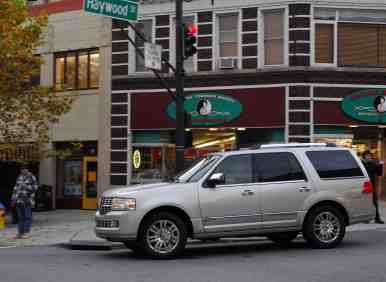Recent Articles
Popular Makes
Body Types
Lincoln Navigator Used SUV Buyer’s Guide
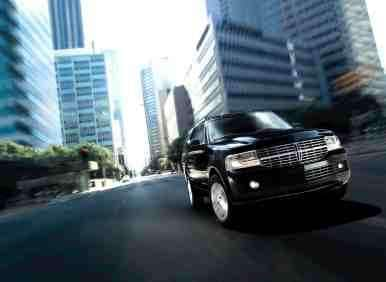
Sometimes being the first-est with the most-est can be a real boon. In the case of the Lincoln Navigator, being first to market gave it a wide-open field in which to run. And yes, Lincoln took full advantage of it. America’s first full-size luxury SUV, the 1998 Lincoln Navigator was a huge hit the minute its tires touched the street.
Embraced immediately by the faction of American culture which establishes trends and tells the rest of the country what has that difficult to define cool factor (and what does not) the crowd that loves things that go bling, christened the Navigator as the luxury SUV of choice — for a while.
Then Cadillac introduced the Escalade — and all of that changed.
What was once the ride to have suddenly became yesterday’s news. Over the ensuing years, Lincoln has tried hard to reinvigorate the Navigator in an effort to make it THE one again, but as anyone who follows fashion knows, fads fade. That bold plaid suit with the five-inch lapels that looked so good last year, looks like a clown suit this year.
That said, the Navigator’s first full year of sales (1998) was its best year at just under 45,000 units sold. Cadillac introduced the Escalade in 1999, but everyone saw that first Escalade for what it was, a warmed-over GMC Yukon Denali. And so they stuck with the Navigator for another couple of years. When Cadillac introduced the refreshed Escalade in 2001, it just barely edged the Navigator out in sales by just under a hundred units.
But that was the turning point.
Momentum shifted in favor of the Cadillac.
By 2010, Navigator sales barely approached 8,300 units, while Escalade sales totaled nearly 27,000. With the fervor over SUVs fading of late, even the Escalade has seen a significant dip in sales. Odds are the Navigator will never see 40,000 units a year again.
The King is dead — long live the King.
However that doesn’t mean the Navigator is wack. In fact, driving a Navigator these days lends one something of an air of exclusivity; you don’t see a new Navigator on the road everyday.
There have been three generations of the Lincoln Navigator offered since the model was launched in August of 1997, as a 1998 model.
1998 – 2002
That first Lincoln Navigator, (as has been each successive one actually) was based on the Ford Expedition, which in turn, was based on the Ford F-150 pickup truck. The ‘Gator offered seating for up to eight people in an extremely plush interior environment. If you know what you were looking at though, you could see it was largely the F-150’s interior treatment reworked for ultra-luxe duty.
To separate the Navigator’s exterior styling from the Ford Expedition, Lincoln’s product planners fitted more elegant front and rear fascias with sleekly designed headlights and taillights. The chromed "waterfall" style grille mimicked the one found on Lincoln’s Town Car of the period and the hood was sculpted to flow back from the grille. Completing the look were a different set of wheels, more pronounced wheel arches, a more graceful roof rack, and a set of luxurious door handles, finished in chrome.
Creature comforts included a four-speaker AM/FM-cassette based premium audio system, as well as a set and forget it automatic climate control unit. Announcing immediately the luxury intentions of the cabin were a wood- and leather-trimmed steering wheel with redundant audio and climate controls. An overhead console, featuring map lighting and electronic information displays complemented power-operated driver and passenger captain’s chairs — along with floor storage consoles in both the first- and second-row.
Naturally, power windows, power door locks and power heated mirrors figured prominently; as did remote keyless entry, illuminated running boards, automatic headlights, foglights, a load-leveling air suspension system, and sixteen-inch alloy wheels.
And yes, all of it was standard equipment.
The options list flaunted seventeen-inch wheels, a power moonroof, a universal garage door opener, and an electrochromic rearview mirror for filtering out headlight glare from vehicles behind the Navigator. The optional seven speaker, 290-watt audio system was fed from a six-disc front console-mounted CD-changer and included rear seat audio controls.
Motive power came from a 230-horsepower, 5.4-liter V8 producing 325 ft-lbs of torque. The four-speed automatic transmission fed the engine’s output to either the rear wheels or all four wheels if the buyer selected four-wheel drive. The 1998 Lincoln Navigator was rated to tow 8,000 pounds.
By the way, the Navigator was fully offroad capable, fitted as it could be with skid plates and a fairly sophisticated (for its time) four-wheel drive system. Turning a dash-mounted knob set the Lincoln's adjustable four-mode Control Trac system to the desired function. Its automatic four-wheel drive mode (A4) fed power to only the rear-wheels unless slippage was detected. It would them apportion power to the front wheels until the rear-wheels bit again. In its four-high mode (4H), traction was maximized for snow, ice, and shallow mud or sand at normal speeds by feeding power to both the front and rear wheels constantly. In its four low mode (4L), engine torque was multiplied to enable the Navigator to climb up steep grades, or out of deep snow. Control Trac’s two-high mode (2H) was best suited for day-to-day driving on streets and highways.
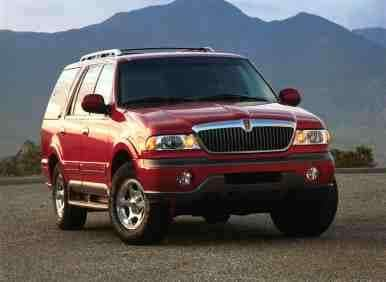
1999
Power adjustable pedals were added to the Navigator’s recipe for 1999, along with a speed-sensitive volume control for the audio system. The third-row seat was fitted with rollers to make it easier to remove for added cargo capacity. The 230-horsepower, 5.4-liter V8 was replaced with a 300-horsepower 5.4 liter, producing 360 ft-lbs. of torque. This upped the Lincoln’s tow rating to 8,500 pounds. Seventeen-inch wheels were made standard equipment. Sat nav, a hands-free cell phone and heated front seats were added to the options list. The 2H mode was dropped from the Navigator’s ControlTrac system.

2000
Cooling capability was added to the driver and passenger seats to make them qualify as “climate controlled”. Side airbags were added as standard equipment and a fully integrated satellite navigation system was offered. A vehicle that big presented some docking problems, so sonar based reverse sensing was fitted as well.
A softer grade of leather was offered for the seats and more genuine wood trim was fitted to improve the ambiance of the interior. The exterior treatment was reworked a bit as well for 2000. The mast antenna was eliminated in favor of an antenna embedded in the right rear window. A new lower body cladding system integrated the running boards more cleanly into the overall design.

2001
A video entertainment system was offered, fed by a VHS videotape player. The background of the Lincoln logo on the back of the vehicle was changed from red to black and the make and model designation scripting was reversed; rather than Navigator Lincoln, it was switched to read Lincoln Navigator.
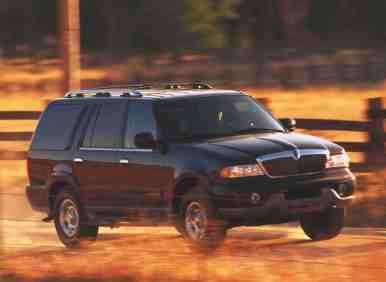
2002
No significant changes were made as an all-new model was in the works for 2003. To move some excess inventory, Lincoln’s product planners came up with a Limited Edition package, which consisted of a special set of wheels, black paint and the reverse sensing system as standard equipment.
2003 – 2006
The second generation Navigator benefited from a complete redesign.
Outside, the grille grew larger, as did the headlights. The chrome door handles were revised and framed by color-keyed bezels. The 2003 Lincoln Navigator featured the industry’s first set of power running boards, which were slightly wider and incorporated more fluidly into the overall exterior design than the boards used on the previous version of the big Lincoln truck.
The 2003 Navigator’s all-new instrument panel and dashboard area, unlike that of the previous generation’s, was not shared with the Expedition. The interior styling of the classic 1961 Lincoln Continental provided the inspiration for the symmetrical, "dual-cockpit" layout. Genuine walnut burl wood warmed the appearance of the instrument panel and dashboard area. A rich, low-luster satin nickel finish complimented the walnut and adorned the panels and switches.
White light emitting diodes (120 LEDs) provided the backlighting for controls and switches. No luxury auto is complete without the requisite analog clock. Lincoln’s interior team directed attention to their satin nickel-faced timepiece by hiding the audio and satellite navigation systems behind an articulating door when they were not in use,
Power-folding third row seats, a power liftgate, and High Intensity Discharge headlights were fitted as well. The rear-seat video entertainment system eschewed videotape in favor of a DVD-based system. All 2003 Navigators wore 18x7.5-inch alloy wheels as standard equipment. Chromed 18x8-inch wheels were an option.
Rack and pinion steering and an all-new independent rear suspension system improved drive quality significantly. The independent rear suspension system also freed up some cargo space and graced the Lincoln with a flat load floor in the cargo area.
Another change ushered in with the 2003 model was the emergence of trim levels for the Navigator. Previously the Navigator was offered in one fully loaded state of trim, with an options list for those who wanted more. With the 2003 Navigator came trim line designations; Navigator Luxury, the base model, offered dual-zone climate control, an in-dash six-disc changer, a roof rack and power-folding side mirrors. Escalating to Navigator Premium bought the AdvanceTrac stability control system, along with heated and cooled seats. To get it all, buyers could get the 2003 Lincoln Navigator Ultimate, which added the power liftgate, power running boards, power-folding third row seats, and high-intensity discharge headlamps to everything above.
The 300-horsepower, 5.4-liter V8 still provided power, but its torque rating was revised to 355 ft-lbs.
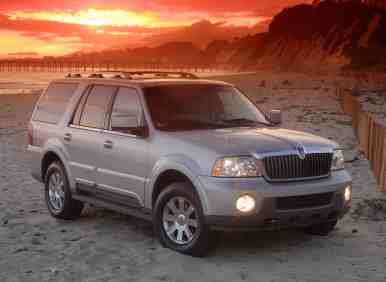
2004
The Premium trim level was dropped, and its components were integrated into the other trim levels. The audio system incorporated separate tweeters for improved sound quality. Tire pressure monitoring was added to the Navigator’s safety gear, along with Roll Stability Control. Satellite radio made its first Navigator appearance — as a dealer-installed option.
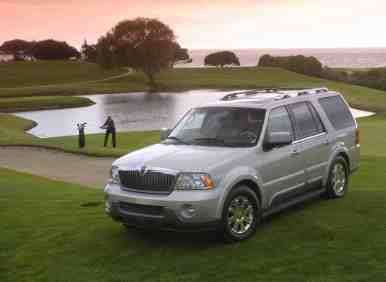
2005
A light facelift replaced the front bumper and its round foglights with square ones. The side cladding was updated as well, which also necessitated a revised appearance for the running boards. A new V8 replaced the Navigator’s 5.4-liter unit with the same displacement and horsepower rating (300), but more torque (365 ft-lbs.). The four-speed transmission was also replaced with a new six-speed unit.
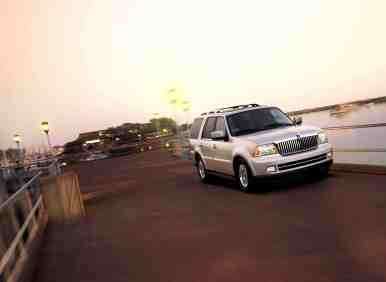
2006
With an all-new model on the way for 2007, the 2006 Navigator went largely unchanged. An Elite trim package was offered for Navigator Ultimate, incorporating a DVD-based satellite navigation system with a voice-activated touch screen, the THX audio system, a rear-seat DVD entertainment system, and HID headlights.
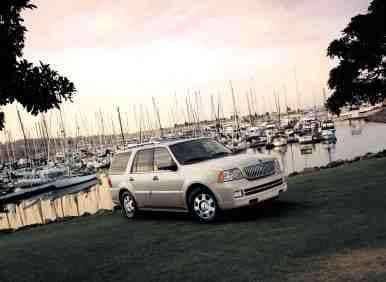
2007 – Current (2012)
Continuing a theme established by the 2003 Navigator, the all-new 2007 Navigator borrowed more styling cues from the classic 1961 Lincoln Continental. This time the exterior appearance of the big Lincoln truck was the beneficiary of an inheritance from its graceful predecessor. The huge new chromed grille was a spiritual homage to that of the storied Continental. The 2007 ‘Gator borrowed from its contemporaries as well, with a taillight treatment inspired by that of its Lincoln MKZ showroom-mate. To up the sparkly factor, chromed trim was liberally applied to the sides and lower body mouldings of the 2007 Lincoln Navigator.
The Lincoln’s platform was made more rigid and the independent suspension system was revised to provide better handling and improved ride quality. Standard wheel size held at eighteen, but all those years of watching aftermarket twenties fitted to Navigators led the product planners to designate a set of twenties of their own from the factory, along with a set of twenty-two’s for “good measure”.
Two trim levels were offered, Luxury and Ultimate; eighteen-inch wheels, parking sensors and turn signal mirrors laced the exterior, while adjustable pedals, leather upholstered power seats, a trip computer and an auxiliary audio input for MP3 players comprised the Luxury model's key offerings.
The 2007 Lincoln Navigator Ultimate added a power rear lift gate; power folding third row seats, heated and cooled seats, an overhead console and a sunroof.
And while most of those features could be ordered as options for the Luxury trimmed Navigator, a' la Carte items for both models included THX audio, a sat nav system, DVD video entertainment, and a set of twenty- or twenty-two-inch wheels.
The updated 5.4-liter V8 from 2005 returned, endowing the 2007 Navigator with an 8,950-pound tow rating. The brake calipers were enlarged, the master cylinder was replaced and the rotors were thickened as well, endowing the 2007 Navigator with better braking ability.
And while all of that was big news, the biggest news of all was the new long wheelbase version of the Navigator, dubbed Navigator L. A full fourteen and a half inches longer than the standard Navigator, Navigator L boasted increased cargo capacity and legroom.
